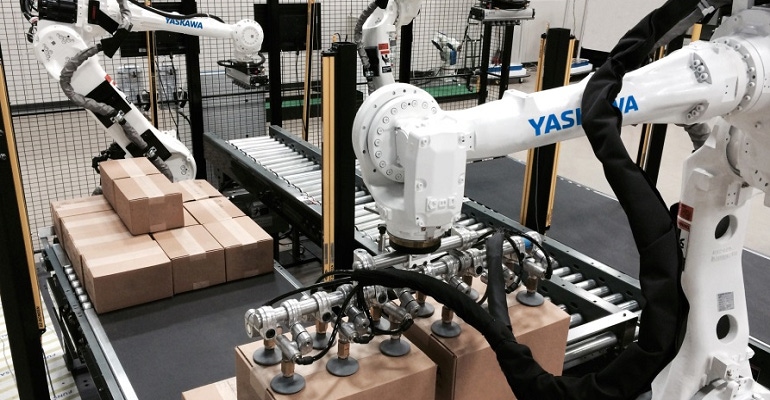Packaging operations need to change on a dime these days. That requires coordinated motion control hardware and software.
March 17, 2021

Twenty years ago, packaging operations put the same product in the same package day after day. That’s when Oreos came in one size and one flavor. Now, Walgreens wants its Oreos in one size package and Walmart wants them in another size. And depending on the season, the cookies are a different color and flavor. That means packaging equipment has to be programmed to switch often and switch quickly.
Motion control systems are designed to help packaging tools provide the flexibility to handle quick changeovers. “What we see in packaging today is a higher number of SKUs and a lower number of manufactured items, lower batch qualities, and multiple products packaged in multiple configurations,” Paul Kling, motion packaging segment manager at Yaskawa America, Drives & Motion Division, told Design News. “The packaging function needs to change in a heartbeat. That can mean changing the machine and adding on additional functions. So, flexibility has become all-encompassing.”
Kling offers a rundown of Yaskawa’s motion control packaging platform, explaining Singular Control for robotics packaging:
The Reality of Packaging Flexibility
Almost every product comes in a variety. For consumer products in food and beverage, customers expect to find what they want in the quantities and in the packaging they want. “I think back to bottled water. When it hit the market, we helped to automate the lines with a single bottle size, and there were two batch sizes, a full case and a partial case,” said Kling. “Now we have to take the manufacturing line and create the flexibility to package them in six-packs, 12-packs and 24-packs, for example. We no longer run the same size for two weeks. We may run one batch size one day and another batch size the next day.”
The move to flexible control systems supports a clear trend towards order customization. "From the order fulfillment side, manufacturers want to deliver the product in a customized manner, moving from the paradigm of mass production to one of mass customization,” Doug Meyer, lead packaging applications engineer at Yaskawa America, Drives & Motion Division, told Design News. "Motion control helps with that. It helps speed the changeover of the machine and provides an interface to the order entry system."
One of the strategies to support flexible packaging operations is the use of flexible programming. "Motion control systems have grown in their ability to help manufacturers get to a 'batch of one' by means of flexible programming methods,” said Meyer. "We all want something you can drop in without much programming, but we're not quite there yet. However, we're always looking to reuse code and develop it in a modular way so that it can be more easily adapted to a different situation. That eases the programming burden."
The ability to reuse code comes in part from the ability to run different code on the same controller. “The good thing about where motion control is going is the move beyond simple ladder programming,” said Meyer. "You can now develop code in C# -- or other appropriate language optimized for the task at hand -- that will run on the same controller alongside more traditional IEC 61131-3 code."
Changing Packaging Operations Without Writing Code
The less original programming you have to write, the easier it is to switch from one operation to another. “You can smartly program the machine to create set points and not alter much of the program when creating different recipes for different products with the same machine or the same equipment,” said Kling. “If you want to run product A, it will be with this program and this speed, but product X is often the same machine running with different set points and speeds and different tooling, a multi-use machine.”
Yaskawa attributes some of the flexibility to motion control equipment providers. “Customers rely on motion control suppliers, whether it’s controller or technology in programming environments. It allows people to program in different platforms and form factors; it produces technology for ease in using machines,” said Kling. “Motion technologies allow you to accomplish things we couldn’t do 15 years ago. If you can implement motion you can create the ability to have full control.”
Control the Robot and You Control Packaging
When motion control tools can control robot movement, you can bring flexibility to packaging. “We’re able to control robot axes with motion control, and that provides the opportunity to add on and alter packaging end-of-line functions very efficiently. said Kling. “A lot of robot technologies allow end-users to add functionality to their end-of-line function requirements, including packing and palletizing. We’ve developed kinematics that can control robot axes, and that brings us flexibility.”
Yaskawa uses a motion control system that can control multiple packaging tools. "We have developed the Singular Control architecture to control a mix of motion equipment, including our 6-axis articulated robots,” said Meyer. "Singular Control uses the same motion function blocks regardless of the mechanism being controlled. This kinematic transparency provides a huge amount of programming flexibility and further reduces the programming burden."
Rob Spiegel has covered manufacturing for 19 years, 17 of them for Design News. Other topics he has covered include automation, supply chain technology, alternative energy, and cybersecurity. For 10 years, he was the owner and publisher of the food magazine Chile Pepper.
About the Author(s)
You May Also Like




